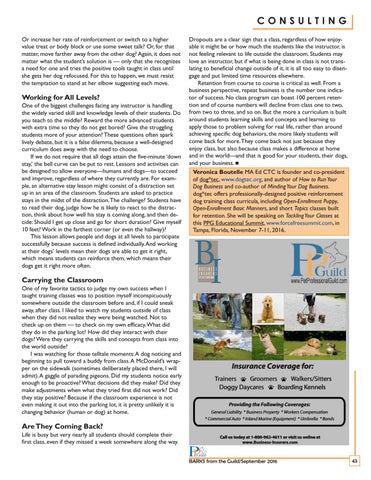Or increase her rate of reinforcement or switch to a higher value treat or body block or use some sweet talk? Or, for that matter, move farther away from the other dog? Again, it does not matter what the student’s solution is — only that she recognizes a need for one and tries the positive tools taught in class until she gets her dog refocused. For this to happen, we must resist the temptation to stand at her elbow suggesting each move.
Working for All Levels?
One of the biggest challenges facing any instructor is handling the widely varied skill and knowledge levels of their students. Do you teach to the middle? Reward the more advanced students with extra time so they do not get bored? Give the struggling students more of your attention? These questions often spark lively debate, but it is a false dilemma, because a well-designed curriculum does away with the need to choose. If we do not require that all dogs attain the five-minute ‘down stay,’ the bell curve can be put to rest. Lessons and activities can be designed to allow everyone—humans and dogs—to succeed and improve, regardless of where they currently are. For example, an alternative stay lesson might consist of a distraction set up in an area of the classroom. Students are asked to practice stays in the midst of the distraction. The challenge? Students have to read their dog, judge how he is likely to react to the distraction, think about how well his stay is coming along, and then decide: Should I get up close and go for short duration? Give myself 10 feet? Work in the farthest corner (or even the hallway)? This lesson allows people and dogs at all levels to participate successfully because success is defined individually. And working at their dogs’ levels mean their dogs are able to get it right, which means students can reinforce them, which means their dogs get it right more often.
CONSULTING
Dropouts are a clear sign that a class, regardless of how enjoyable it might be or how much the students like the instructor, is not feeling relevant to life outside the classroom. Students may love an instructor, but if what is being done in class is not translating to beneficial change outside of it, it is all too easy to disengage and put limited time resources elsewhere. Retention from course to course is critical as well. From a business perspective, repeat business is the number one indicator of success. No class program can boast 100 percent retention and of course numbers will decline from class one to two, from two to three, and so on. But the more a curriculum is built around students learning skills and concepts and learning to apply those to problem solving for real life, rather than around achieving specific dog behaviors, the more likely students will come back for more. They come back not just because they enjoy class, but also because class makes a difference at home and in the world—and that is good for your students, their dogs, and your business. n Veronica Boutelle MA Ed CTC is founder and co-president of dog*tec, www.dogtec.org, and author of How to Run Your Dog Business and co-author of Minding Your Dog Business. dog*tec offers professionally-designed positive reinforcement dog training class curricula, including Open-Enrollment Puppy, Open-Enrollment Basic Manners, and short Topics classes built for retention. She will be speaking on Tackling Your Classes at this PPG Educational Summit, www.forcefreesummit.com, in Tampa, Florida, November 7-11, 2016.
Carrying the Classroom
One of my favorite tactics to judge my own success when I taught training classes was to position myself inconspicuously somewhere outside the classroom before and, if I could sneak away, after class. I liked to watch my students outside of class when they did not realize they were being watched. Not to check up on them — to check on my own efficacy. What did they do in the parking lot? How did they interact with their dogs? Were they carrying the skills and concepts from class into the world outside? I was watching for those telltale moments: A dog noticing and beginning to pull toward a buddy from class. A McDonald’s wrapper on the sidewalk (sometimes deliberately placed there, I will admit). A gaggle of parading pigeons. Did my students notice early enough to be proactive? What decisions did they make? Did they make adjustments when what they tried first did not work? Did they stay positive? Because if the classroom experience is not even making it out into the parking lot, it is pretty unlikely it is changing behavior (human or dog) at home.
**OTVSBODF Coverage OTVSBODF Coverage for for Gr oomers W alkers/Sitters Trainers Trainers Groomers Walkers/Sitters D oggy Da ycares Boarding Kennels Doggy Daycares Boarding 1SPWJEJOH UIF 'PMMPXJOH $PWFSBHFT 1SPWJEJOH UIF 'PMMPXJOH $PWFSBHFT (FOFSBM -JBCJMJUZ #VTJOFTT 1SPQFSUZ 8PSLFST $PNQFOTBUJPO ( FOFSBM -JBCJMJUZ #VTJOFTT 1SPQFSUZ 8PSLFST $PNQFOTBUJPO $ $PNNFSDJBM "VUP *OMBOE .BSJOF &RVJQNFOU 6NCSFMMB #POET PNNFSDJBM "VUP *OMBOE .BSJOF &RVJQNFOU 6NCSFMMB #POET
Are They Coming Back?
Life is busy but very nearly all students should complete their first class, even if they missed a week somewhere along the way.
at Call us today at 1-800-962-4611 or visit us online at www. www.#VTJOFTT *OTVSFST.com #VTJOFTT *OTVSFST.com
BARKS from the Guild/September 2016
43
